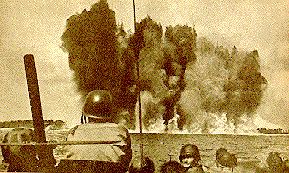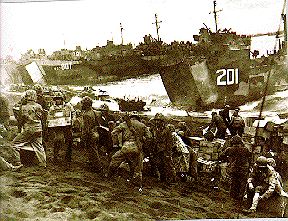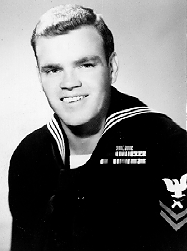WWII UNDERWATER DEMOLITION TEAMS
(1943-1945)
Underwater Demolition Teams were the answer found during World War II to the
problem which led to heavy Marine Corps losses in the invasion of Tarawa in the Pacific in 1943, and which faced the Allied Expeditionary Force
before the invasion of Normandy
in 1944.

The waves of landing craft carrying troops of the famous Marine Second Division
onto the beaches of Tarawa, went
aground on a submerged coral reef which had not been revealed by aerial
reconnaissance photos about a mile and a half from the beach, thus forcing the
troops to wade the long stretch in hip deep water under withering Japanese
fire. Losses were thus tragically high before the landing force was even afoot
on the Island. It was painfully apparent to staff planners of all
services that the success of future amphibious invasion of Japanese held
territory would be in jeopardy if there was to be no way of knowing what
obstacles, both natural and man-made, lay to seaward of the beach, and if there
were no way of clearing such obstacles.

In the meantime the plans were nearing completion for the invasion
of the German held Normandy coast by the Allied Expeditionary Force. It was
evident that the Germans' initial line of resistance would be mines and
underwater obstacles designed to stop the invasion craft. Navy planners therefore
conceived the Combat Demolition Units, which would go
in with the first wave at Normandy
and supplement the Army beach sappers who were faced with the problems of clearing
gaps through barbed wire, walls and tank traps.
The first personnel were garnered from the CB's, the Navy Construction
Battalion Men, and from the early Navy/Marine Scout and Raider Volunteers who were rugged
and capable physically and who had previous swimming experience. They were
collected together at Fort Pierce, Florida, in the early summer of 1943. An intensive physical
training program was devised, apparently based on the theory that a man is
capable of about 10 times as much physical output as is the normal conception.
Demolition work was emphasized and non-restricted. Methods were
developed for demolishing the type obstacles expected at Normandy. Grueling nighttime problems conducted in the snake
and alligator infested swamps of Florida produced a specimen of man who was at
home with mud, noise, exhaustion, water, and hostile beings, human or
otherwise.
The graduates of the school were organized into small 6 man units,
which were called Navy Combat Demolition Units, and a
large number were sent to England to join the large invading force in the winter of
1944. No one there knew exactly what they were or what to do with them and it
was only after many weeks of being shipped around to various stations and being
used merely for watches and guard duty, that they were
finally able to settle down for training and invasion rehearsals. Additional
men were picked up to swell the units from all sorts of commands, and though
previously untrained, these men were fitted into the six man and one officer
units.
These men were our original ancestors and no amount of honor
bestowed upon them will be excessive; they will always have a place in the rank
of history's gallants. The story of the two American beaches at Normandy, Utah and Omaha, has been recorded in detail and is available in
many sources. Operations on Utah beach proceeded with relative ease and pretty much
as planned, but at the same time Omaha Beach was like the entrance to Hell. The NCD Units
accompanied the assault infantry in the boats of the first wave.
The NCDU men did not anticipate any swimming, for the
clearance was to be conducted at low tide. They wore impregnated, hooded,
canvas fire fighting suits, with field shoes and long stockings, also
impregnated. A protective mask covered the bare part of the face; this garb was
in anticipation of a spray of mustard gas.The
invasion force was wet and seasick after the two day delay on the rough
channel. As they neared the beach it was obvious that the preliminary
bombardment had been made and lifted on schedule, but the cloudy skies had made
it impossible for planes accurately to hit the enemy strong points.
The Germans had reserves available at Omaha and immediately replaced losses at bombarded
bunkers. As the boats neared the beach the enemy fire began to fall. Within
minutes the water was littered with debris and wrecked craft, and many
demolition units were wiped out altogether. An example of the discouraging
losses in this H-Hour period was the fact that out of some 20-30 amphibious
tanks which were to give supporting fire, only four were seen in action. The
Demolition Men proceeded nevertheless to set up charges at their assigned gap
spots. There was no shelter on the side sand field, and the men worked as
though in a rainstorm, only instead of rain there was shrapnel. The
disorganized and misplaced infantry were seeking shelter behind some of the
charged obstacles, and were tripping over the detonating cord lines laid out
between obstacles. In four places however, they heeded the purple warning
flares, and four gateways to France were unveiled with tremendous triumphant explosions.
The NCDU losses at Utah were 30%, and at Omaha about 60-70%, giving an over-all average loss of 41%
men lost in the assault.
The survivors of this great day were shipped to the Pacific to
form the nucleus of the great force being formed. They had not utilized their
swim training in Europe but were now to do so. The lessons of Normandy were applied to the amphibious problems of the Pacific Islands, and the basic tactics were developed that still are the basis for
operational procedure today. The concept of 6-man NCDU was changed to embrace a
structure of Underwater Demolition Teams, consisting of 100 men and 13
officers, two or three of which comprised a unit,and in turn, several of these units comprised
squadrons.
Basic training was still conducted at Fort Pierce, Florida, followed by six weeks of advanced training at Maui, Hawaii, which became a staging area for advance operations.
The main story of UDT comes out of the Pacific operations which were all done
in approximately the same manner. The highly developed methods made UDT
operations an effective and well invested weapon and after the Normandy operation until the end of the war, losses were only
about 1%. 28 or 29 Teams were now in combat operations; Borneo, Peleliu, Saipan, Tinian, Guam, Lingayen and Leyte Gulfs, Iwo Jima,
and in conclusion, Okinawa. At the end of the war there were 34 teams in commission,
about 3500 men in all.
They were all combined into 5 tremendous teams designated A, B, C, D, and E
for purposes of demobilization. The thousands of fins, coral shoes and face masks
were stored in warehouses and the reservists went back home to their civilian
occupations and lives; the others were sent to duties on ships and stations as
their individual rates called for.
The above history was written in 1960 by
W.H. Hamilton, Jr., Commander Underwater Demolition Unit TWO

During WWII there were 32 individual UDT Teams with over 3,000
men total. If you were one of them, your teammates would like to hear from you.
UDT-3 teammates will be happy to know that Clarence "Mullie" "Moe" Mulheren,
Jr., USNR, Ret. published a newsletter, THE
SEA
BREEZE, and coordinated annual reunions of teammates.

Clarence "Mullie"
Mulheren, UDT-3
(Mullie passed away October 27, 2009)

UDT-6 (second Team SIX) formed in 1945teammates are encouraged to contact Bob Broxholme, 1544 11th Avenue, Escondido, California 92029.

UDT 8, 9,
and 10 teammates are encouraged to contact William P. (Pete) Katsirubas or Wright Travis for information
about the whereabouts of former teammates. Write to William Katsirubas,
7126 Merrimac
Drive, McLean, Virginia 22101 or Wright Travis, 1270 Harwood Drive, Libertyville, Illinois 60048

UDT 13 Team historian,
Marvin Cooper has written a detailed history, THE MEN
FROM FORT PIERCE.

UDT 14 William
Harrison's cousin has a website with photos and roster of UDT 14.

UDT-19 teammates are celebrating the 53rd anniversary of the formation of the
Team on November 20, 1944, and their motto is "Over the sea for
'53". For information contact Phil Koehler, 1341 Kukila Street, Honolulu, Hawaii 96818.

UDT-22 teammates may want to contact Hank Ostendorf
for more information about former teammates.
Henry Ostendorf
690 SW 25th St.
Vero Beach, Florida 32962

WWII Underwater Demolition Team Histories
NSWA home
![]()

![]()
![]()
![]()
![]()
![]()
![]()
![]()